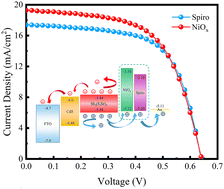Enhancement in the efficiency of Sb2(S,Se)3 thin-film solar cells with spin-coating NiOx as the hole transport layer†
Abstract
The photovoltaic conversion efficiency of Sb2(S,Se)3 thin-film cells is significantly limited by carrier recombination at the back-contact interface. Therefore, an increasing number of studies have focused on back-contact interface optimisation. This study enhances the photovoltaic conversion efficiency of Sb2(S,Se)3 thin-film solar cells by utilizing NiOx as the hole transport layer (HTL). The inclusion of NiOx helps address the mismatch between the energy-level alignment of Sb2(S,Se)3 and the metal electrode, resulting in increased carrier collection efficiency and reduced carrier recombination at the back-contact interface, thus enhancing the performance of solar cells as a result. Under the same conditions, the NiOx film has a more suitable energy-level alignment with the Sb2(S,Se)3 film than the device fabricated with spiro-OMeTAD as the HTL, as it can extract and transport holes more efficiently and block electron transport. In addition, the influence of solution concentration and the annealing temperature on the NiOx film and device has undergone extensive investigation. The final NiOx device achieved a photovoltaic conversion efficiency of 7.40% and maintained an initial efficiency of 92% after 700 h, showing higher stability than the spiro-OMeTAD device. These findings show the enormous potential of NiOx as a hole-transport layer and offer fresh perspectives on choosing hole-transport layers for Sb2(S,Se)3 thin-film cells.

- This article is part of the themed collection: Journal of Materials Chemistry C HOT Papers


 Please wait while we load your content...
Please wait while we load your content...